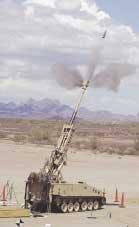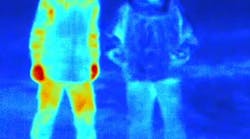Sensors
Raytheon uses M/A-COM telemetry sensor for artillery shell
Engineers at Raytheon Missile Systems in Tucson, Ariz., needed a telemetry sensor for their XM982 Excalibur projectile program. They found a solution with M/A-COM Inc. in Lowell, Mass.
Excalibur is a future U.S. Army smart munition set for use by 2006. It will use global positioning system-aided inertial guidance and navigation to hit targets from as far away as 20 miles. This 155-mm guided artillery projectile is for the Future Combat System (FCS) non-line-of-sight (NLOS) cannon. Army designers may also adopt the M-109 Paladin self-propelled howitzer to fire the Excalibur.
M/A-COM’s Tactical Telemetry Module (TTM) monitors on-board sensor and system health information during the projectile’s flight and throughout its life cycle. The unit is an integrated module with signal conditioning, data encoding, S-Band transmitter, and power-control.
M/A-COM is a business unit of Tyco Electronics and a provider of wireless radio frequency (RF), microwave, and millimeter wave components. For more information, see www.macom.com.
Displays
Team US101 uses helicopter display from Smiths Aerospace
Designers at Team US101 needed a cockpit display suite for the US101 medium-lift helicopter. They found a solution with Smiths Aerospace Electronic Systems business, Grand Rapids, Mich.
Team US101, led by Lockheed Martin Systems Integration-Owego in Owego, N.Y., is designing a helicopter to bid for the U.S. Navy’s presidential helicopter replacement (VXX) program, also known as Marine One. The US101 aircraft is an American variant of AgustaWestland’s EH101 multimission helicopter.
The aircraft will use the SDS-5000 large-area cockpit display system - a five-screen, large-area integrated cockpit display suite.
The 10-by-8-inch liquid-crystal displays provide more than 70 percent additional display area compared to the Smiths’ SDS-4000 display system it replaces.
The new displays can show enhanced situational awareness and greater flexibility in the display of flight, system, and mission data. Each display unit has multifunctional bezel-mounted keys to select information. For more information, see www.smiths-aerospace.com.
Software
Lockheed Martin designs satellites with NX Nastran
Engineers at Lockheed Martin’s Engineering Process Improvement (EPI) Center, in Camden, N.J., needed software to run finite-element analysis on satellite designs. They found a solution in NX Nastran from UGS, in Plano, Texas.
Lockheed Martin designers use NX Nastran to evaluate the structural performance of products from launch vehicles to satellites.
“We carried out an extensive evaluation of NX Nastran prior to this agreement,” says Steve Butt, director, Lockheed Martin EPI Center. “In addition, we reviewed UGS’ long-term commitment to research and development as well as the company’s Nastran technical support infrastructure. We are committed to NX Nastran as our high-performance CAE solver and are recommending it for deployment throughout Lockheed Martin.”
UGS launched NX Nastran in September 2003. Nastran, the world’s most widely used finite-element-analysis (FEA) software, was previously primarily available only from MSC.Software Corp. as MSC.Nastran. Today, NX Nastran enables companies to accurately predict functional performance and evaluate multiple product design alternatives more efficiently. For more information, see www.ugs.com or www.ugsolutions.com.
Northrop Grumman will design destroyers with Dassault software
Engineers at Northrop Grumman Ship Systems in New Orleans needed computer-aided design software to help them create the U.S. Navy’s 21st-century surface warship, the DD(X). They chose IBM PLM Solutions, from Dassault Systemes in Paris.
Northrop Grumman, leading a development consortium of six companies and more than 100 suppliers, will use the software as a collaborative product development environment for the project.
The group will use CATIA V5 for 3D product-development; ENOVIA Life Cycle Applications (LCA) for product data and lifecycle management; and may also use DELMIA, for digital factory and manufacturing process development. Together, Northrop Grumman and its partners will deploy nearly 600 licenses of CATIA V5 and ENOVIA. For more information, see www.3ds.com.
DD(X) is the centerpiece of the Navy’s technological transformation and is the cornerstone for a new family of surface combatants to be built over the next 25 years.
The program includes 10 transformational technologies for new destroyers, as well as for today’s fleet of Aegis-equipped cruisers and destroyers. Navy leaders say they plan to develop the DD(X) fleet over the next four years, with detailed design starting in 2005 and the lead ship entering service in 2011.
“We have a unique vision and strategy that will ultimately transform ship design,” says Philip A. Dur, corporate vice president, and president of Northrop Grumman’s Ship Systems Sector. “As with our counterparts in the aircraft business, we needed the tools that would enable a better way of designing and building ships. This technology will drive a new stream of opportunities to support ships we build over the life cycle, to enhance collaboration with our suppliers, and to exceed our customers’ expectations.”
Cabling
Lockheed Martin uses LaBarge cables for missile defense
Engineers at Lockheed Martin needed a family of cable assemblies for the Chaparral air-defense missile system.
They found a solution at LaBarge Inc. in St. Louis. Working through February 2005, technicians at LaBarge will make $1.4 million of the assemblies at their Berryville, Ark., facility.
The contract specifies more than 80 different cable configurations to interconnect major electronic subassemblies within the Chaparral launcher system.
Lockheed Martin’s Chaparral is a short-range air defense missile system designed to defeat low-altitude, fixed-wing, rotary- wing, unmanned-aerial-vehicle, and cruise-missile threats.
U.S. troops have used the Chaparral in fixed-site, land-mobile, and shipboard applications. LaBarge has produced the cable assemblies used in the missile launch system for more than a decade. For more information, see www.labarge.com.
Computers
NASA satellite to use Spectrum communications system
Engineers at Techno-Sciences in Lanham, Md., needed an integrated communications subsystem for a search-and-rescue satellite they are building for NASA. They found a solution with Spectrum Signal Processing Inc. in Burnaby, British Columbia.
Spectrum will supply an integrated satellite communications subsystem, as part of the Distress Alerting Satellite System (DASS) Developmental Local User Terminal (DLUT), which is under development for the National Aeronautics and Space Administration (NASA)’s Goddard Space Flight Center, in Greenbelt, Md.
The DLUT system uses global positioning satellites to provide real-time global distress detection and location. This system is expected to reduce terrain blockage, so rescuers can locate and respond to critical situations.
The system will also provide two-way, nonvocal digital messaging to inform the sender that the beacon alert message has been received. The initial DLUT development phase is scheduled for completion by early 2005.
Spectrum’s integrated satellite communications subsystem incorporates the company’s XMC-3310 module. The RapidIO-based XMC-3310 module incorporates several Xilinx Virtex-II Pro field-programmable gate arrays and Analog Devices’s analog-to-digital and digital-to-analog converters. For more information, see www.spectrumsignal.com.
“We selected Spectrum based on its robust commercial off-the-shelf (COTS) product offering and its demonstrated understanding of satellite communications systems,” says Gilmer Blankenship, chairman of TSi. “TSi expects to employ Spectrum products in both its current and next generation commercial search and rescue satellite systems.”






